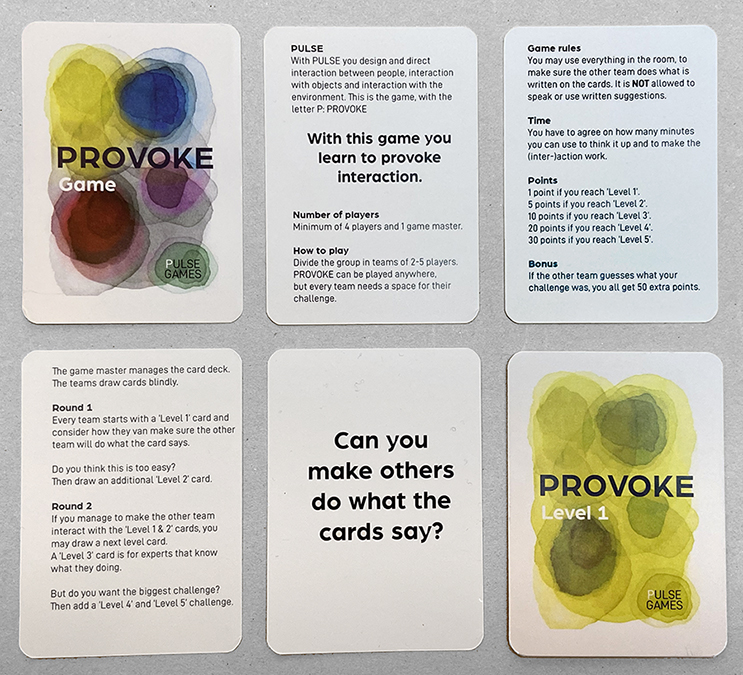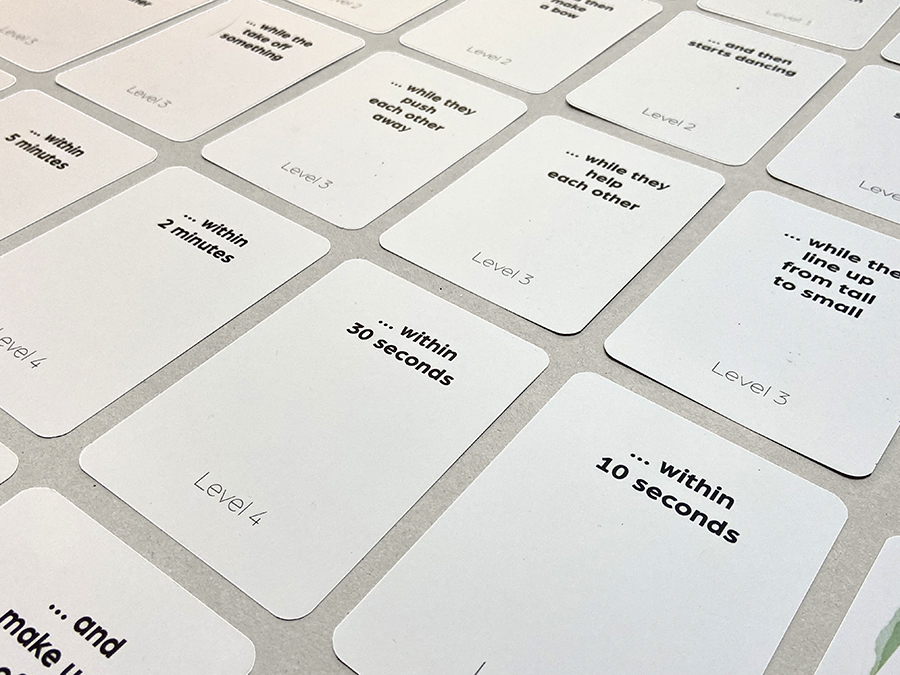I think people are more alive, involved and active when they interact. Therefore, I always wanted to learn how to provoke interaction with and between other people. This interest has driven my practice of spatial design, theatre-making and education. Over the past twenty years, I have experimented with provoking, designing and directing interactions in artistic, social and educational situations. My goal is always to enhance and intensify the experiences of others, either aesthetic or learning experiences.
During the first months of my design research, I constructed the PULSE model as a dramaturgical foundation for interactive projects. I based the model on an analysis of the mechanics of my interactive theatre plays, the spaces I designed and the lessons I gave.
The next step in my design research was to develop tools to explain and convey the PULSE model to other designers, teachers, managers and civil servants who want to activate people. I will share my experiments and findings with you in this blogpost, and zoom in on the development of a game, called PROVOKE, with which I introduce the model.

LET’S PLAY A GAME
I want you to think of the first time you fell in love. Can you remember when this happened? Do you know where you were? What was it that sparked your feelings? Was it the words that were spoken to you? Was it the way the other looked or danced? Or perhaps the music and the atmosphere played a role in creating the perfect moment to fall in love. I bet it was a combination of things that sparked this shot of testosterone, dopamine and oxytocin (Katherine Wu, 2017)1. The other person provoked an exciting interaction, that changed your mood and perhaps even your life. Butterflies flew in your belly, and you probably felt energized and alive.
With the questions, I have tried involving you and your personal experience in this blog post, because of the sensory richness of the experience and the universal aspect of it. Almost everyone can relate to a resembling situation. By revisiting this experience, I want to make you aware of the importance of provoking interaction. If no one had provoked this feeling, you would have missed out on the butterflies. I also want to show the multiple elements that are in play, like I mentioned above: space, sound, movement, signs, smell and time. These are all non-verbal communications. As a designer, director, manager or teacher, you can influence these elements and thereby influence the interaction between people and with their environment.
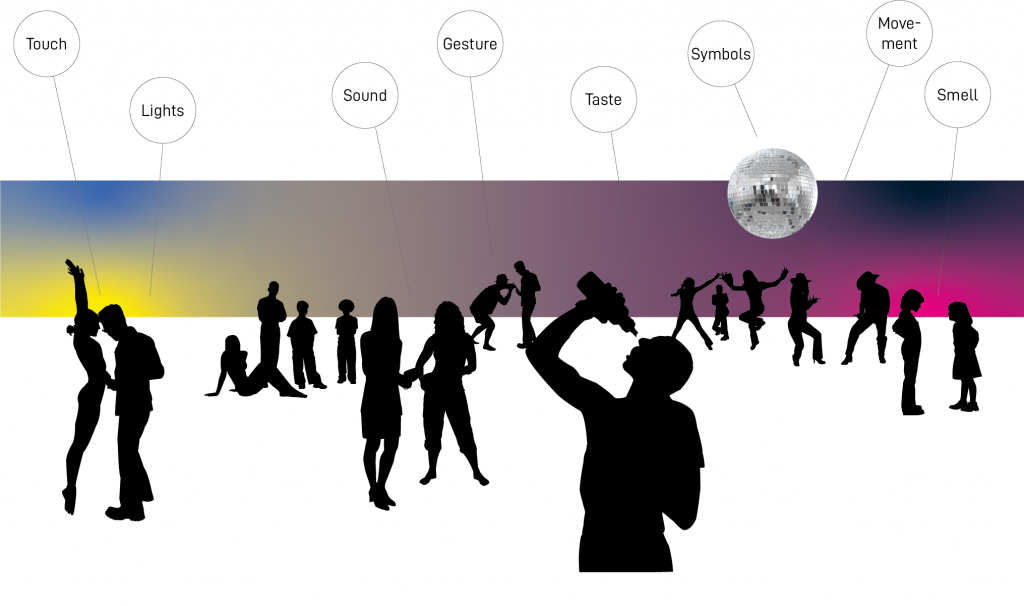
PRACTICE WHAT YOU PREACH
Initially, I analysed my practice and externalized this through designing diagrams of the dramaturgy and the PULSE model. ‘Externalization is the process of making tacit knowledge explicit, wherein knowledge is crystallized and is thus able to be shared by others, becoming the basis of new knowledge.‘ (Nonaka & Takeuchi, 1995)2 The diagram and fifty basic strategies enabled me to visualize and make the interaction process explicit.
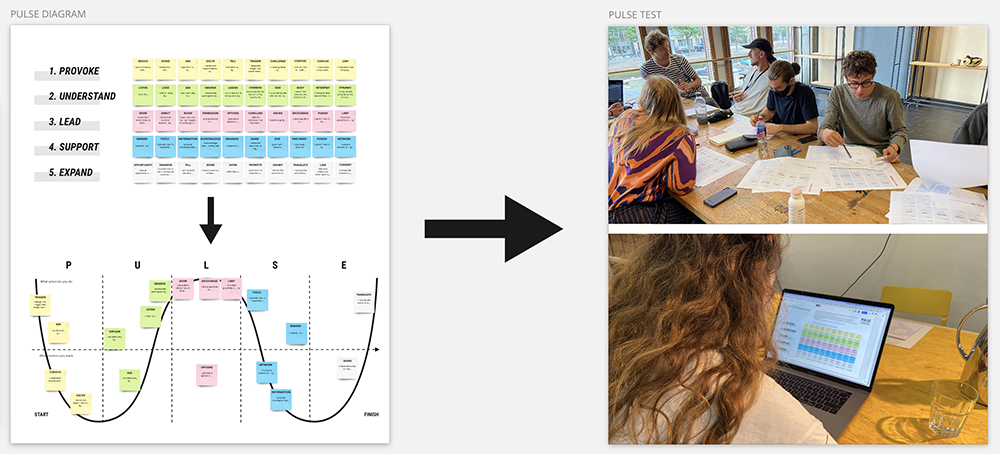
Yet, when I told someone about PULSE, they did not really respond. When I showed them the diagram, they were not immediately triggered or motivated to use it themselves. I had to find alternative ways to convey or transfer PULSE. This is when I remembered a quote attributed to Confucius.
tell me, and I will forget
show me, and I may remember
involve me, and I will understand
Confucius, 450 b.c. 3
This quote reflects the mentality I am advocating, making it obvious to adopt it to my research. I, therefore, made it my mission to involve my students, my peers and other participants, in order to effectively introduce the PULSE model.
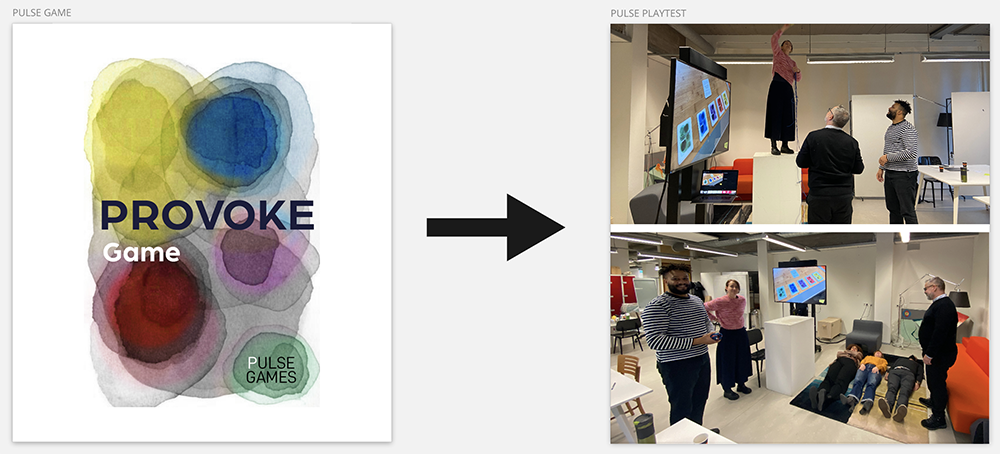
PROVOKE INTERACTION
I developed a game called ‘PROVOKE’ to introduce various strategies to provoke interaction. The game revolves around challenges to designing situations that make participants behave in a certain way. All cards describe a simple action that your team needs to let the other team do. The more cards you combine, the harder it gets. For instance, can you make the other team touch all walls and then close their eyes? There is only one rule: no spoken or written instructions are allowed, thereby focussing on non-verbal communication. My goal is to let participants design alternative ways to provoke interactions using the space, objects and each other in a makeshift way.
GAME DEVELOPMENT
During a Ludodidactics Summer Course at the HKU in Utrecht, I developed the first version of the game. This first iteration was complex and had too many written game instructions. Therefore participants did not relate to the game or could connect it to their own practice. In the second iteration, I was able to reduce instructions, because I also reduced the number of game actions. Challenges were chopped up into small tasks that could be executed in all circumstances and environments. This second version was played and reviewed by my peers from the summer course as well.
During this play-test, players showed intrinsic motivation and were engaged in the game more than in the first version. Compared to the first game, they could see the potential use and impact of the game. They suggested applying this game in other domains, such as UX designers, teachers and exhibition designers, for instance. After the play-test, participants focussed their feedback on the points system, which could reward not only the actual provocation but also the understanding of the challenge.
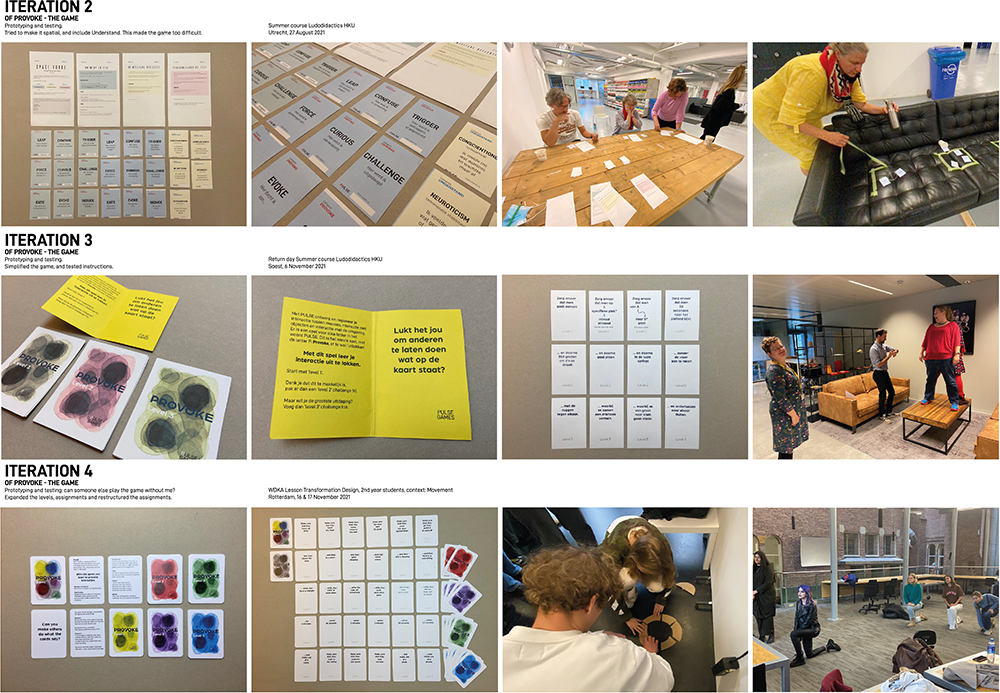
If ‘the other team’ could guess what the challenge was, both teams could earn 50 bonus points. With that rule added, I included the ‘U’ or ‘Understand’ from the PULSE model in the game. According to my peers in the Ludodidactics course, this enhanced the feeling of competence, autonomy and relatedness, and thereby the learning curve. Additional play-tests with students and colleagues of the Willem de Kooning Academy in Rotterdam confirmed that the new bonus rule works: it led to extensive participant insights and feedback. For me, the insight was that the game managed to provoke their interest and convey parts of the PULSE model.
DIFFERENCES IN PLAYING
When I play-tested the third iteration of the PROVOKE game with Willem de Kooning Academy ‘Transformation Design’ students and ‘Spatial Design’ students, I noticed that the strategies were similar, but the means or tools differed. Where the Transformation Design students deployed performance-based tactics and used their bodies to pretend and act out the instructions, the Spatial Designers used cardboard, tape and symbols to trigger actions that were on the cards. Both types of students used the tools familiar to them through their current projects. This taught me that the game offers the players options to design and direct interactions in a way that fits their particular practice, and thereby could relate to PULSE.
Players furthermore experience two perspectives or positions: from the ‘user’ perspective and from the point of view of the designer or director. And as all participants took turns in being designers or users, they engaged in a steep learning curve, because they were provoking and were being provoked. This is another major takeaway from this part of the research. It revealed to me the importance of switching positions and exchanging experiences in interaction.

INTRINSIC MOTIVATION
As a practitioner I want participants to develop a sense of co-ownership, in theatre, in design and in education. This feeling of shared responsibility and connectedness has proven in my theatre plays and lessons, to enhance the aesthetic and learning experiences of students and ‘spect-actors’.
A sense of co-ownership is easier to accomplish when the initial encounter is based on the participant’s self-motivation, I have noticed through my practice. If, on the other hand, participants are forced or told to do something (not intrinsically motivated) the process towards developing a sense of co-ownership is more difficult, in my view. Ryan and Deci (2000)4 describe this and state that the innate psychological need for competence, autonomy and relatedness is linked to enhanced or diminished intrinsic motivation.
In the PROVOKE game, intrinsic motivation is triggered and nurtured through clear growth of competence. This becomes tangible by playing multiple rounds and including feedback in between the rounds. The autonomy is fed by offering participants the option of coming up with their own tactics and solutions. The game offers relatedness by taking turns being both a designer and a user.
I loved to do it.
such a small activity
yet such a rich experience,
that you can elaborate on,
on so many levels.
And it is great fun!
Paul Pos, associate professior Education Station WDKA – December 2021
NOW YOU PROVOKE!
At the end of this blog post, I want you to think back again. Has there been anyone who fell in love with you, at some point in time? When did you realize and understand that this happened?
What did you do to provoke this feeling in the other person? Maybe it was your dance moves or the way you smelled and looked. Perhaps you were in the right space, was it the right time? Consciously or unconsciously, you provoked an interaction. But did you understand the reaction and the changing emotions and behaviour?
When you work as a designer or educator, civil servant or manager looking for ways to activate people, provoking interaction should be part of your professional toolbox. Learning how to provoke through the PULSE model helps to create an effective strategy for provoking, designing and directing interaction. If you want to play the PROVOKE game or want to know more about the other verbs in the PULSE model, please email me: info@powerboat-rotterdam.nl
YOUR CHALLENGE
Let’s play PROVOKE: can you make someone look at the ceiling, and then make them dance, all without spoken or written instructions? You will get 50 bonus points if the other person guesses what your challenge was. Go for it!

LEXICON
PULSE
The PULSE model provides a dramaturgical foundation for many interactive processes, such as interactive theatre plays, knowledge creation and education, UX design and spatial design, amongst others. It provides a designer, educator or theatre-maker with a tool to design and direct the process of interaction.
PULSE is developed by Bas Kortmann and Fokka Deelen, founders of Powerboat -Theatre and Design in 2021, based on an analysis of their interactive practice and experience.
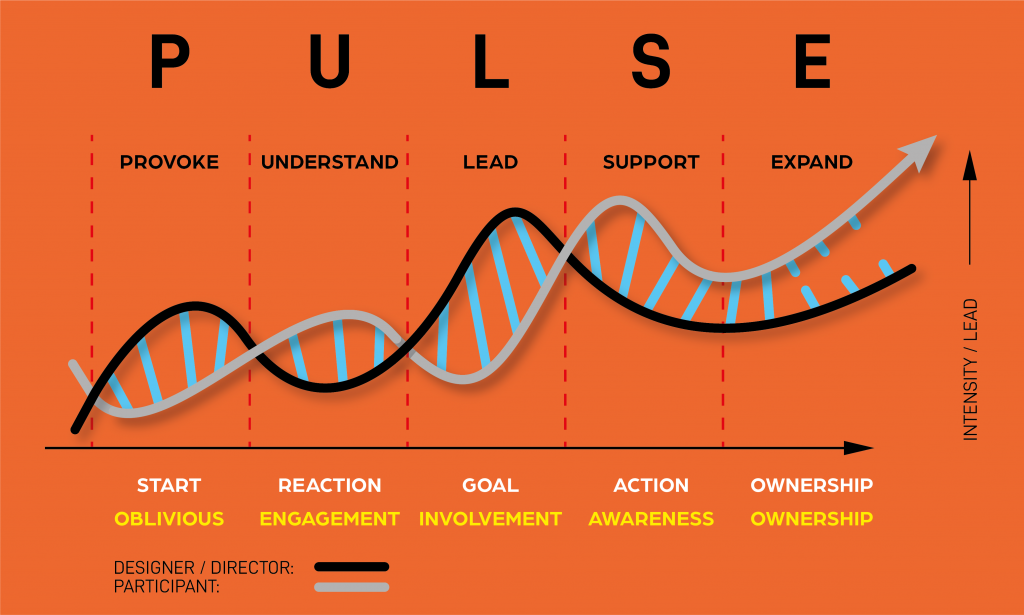
PULSE starts with the ‘P’ of Provoking actions and the ‘U’ of Understanding reactions, getting an action-reaction cycle going and thereby involving participants in the process, game or play.
I can then, as a director of interaction, Lead and Support the participants towards a certain goal. That is what the ‘L’ and ‘S’ stand for.
Finally, the ‘E’ represents Expanding the outcome, when the participants feel a sense of ownership. When they develop their own opinions, when students are able to teach others, or when residents adopt responsibilities, for instance.
LUDODIDACTICS
The name ludodidactics was given to a design method that has been under development since 1995, which culminated in the publication of the book ‘Ludodidactics: design for didacticians’5 by pioneering education professionals, Willem-Jan Renger and Evert Hoogendoorn. This book is about this design method, rooted in two fields: game design and didactics.
The book is also available in Dutch. Both editions can be ordered through the HKU book shop.
SPECT-ACTOR6
Spect-actor is a blend of spectator and actor, coined by theatre practitioner, drama theorist, and political activist Augusto Boal, in his book ‘Theatre of the Oppressed’ written in 1973, first published in 1974 as ‘Teatro di Oprimido.
‘It refers to the dual role of those involved in the process as both spectator and actor, as they both observe and create dramatic meaning and action in any performance.
Equally, the term “spect-actor” can be attributed to the participants in invisible theatre (who are unaware that they are part of a theatrical production but nevertheless contribute to the discussion) and image theatre (who, upon viewing the image created, may alter it to reflect their own ideas).
Boal emphasizes the critical need to prevent the isolation of the audience. The term “spectator” brands the participants as less than human; hence, it’s necessary to humanize them, to restore to them their capacity for action in all its fullness.
They free themselves; they think and act for themselves. Boal supports the idea that theatre is not revolutionary in itself but is a rehearsal of revolution.’ (Wardrip-Fruin, 2003)7
INTRINSIC MOTIVATION
In their article, Ryan and Deci write ‘Humans can be proactive and engaged, or alternatively, passive and alienated, largely as a function of the social conditions in which they develop and function.’ ‘… Specifically, factors have been examined that enhance versus undermine intrinsic motivation, self-regulation and well-being.
According to Ryan and Deci, these findings are significant in domains such as health care, education, work, sport, religion and psychotherapy. The fullest representations of humanity show people to be curious, vital and self-motivated. At their best, they are agentic and inspired, striving to learn; extend themselves; master new skills and apply their talents responsibly.’8
REFERENCES
1. Wu, Katherine, Blog post “Love, Actually: The science behind lust, attraction, and companionship” Harvard University 2017
https://sitn.hms.harvard.edu/flash/2017/love-actually-science-behind-lust-attraction-companionship/ – Januari 2022
2. Nonaka, Ikujiro, and Hirotaka Takeuchi. 1995. ‘The knowledge creating company: how Japanese companies create the dynamics of innovation.’ New York: Oxford University Press. ISBN 978-0-19-509269-1.
3. https://www.le.ac.uk/ebulletin-archive/ebulletin/features/2000-2009/2006/05/nparticle.2006-05-19.html – January 2022
4. Ryan, Richard M. and Deci, Edward L. University of Rochester. ‘Self-Determination Theory and the facilitation of Intrinsic Motivation, Social Development and Well-Being’, The American Psychologist, published by the American Psychological Association (United States), 2000.
5. Renger, Willem-Jan & Hoogendoorn, Evert. ‘Ludodidactics: design for didacticians’, 2019. Publisher: Uitgeverij it&fb i.s.m. HKU Press, Utrecht. ISBN 978-90-640388-3-9.
6. Boal, Augusto. ‘Theatre of the Oppressed, New Edition’. Pluto Press London. Published in: 2019 ISBN 978-0-7453-3929-0
7. Wardrip-Fruin, Noah, and Nick Montfort. “From Theatre of the Oppressed”. The NewMediaReader. Cambridge, Mass.: MIT, 2003. p. 339-52. Print.
8. Ryan, Richard M. and Deci, Edward L. University of Rochester. ‘Self-Determination Theory and the facilitation of Intrinsic Motivation, Social Development and Well-Being’, The American Psychologist, published by the American Psychological Association (United States), 2000.


